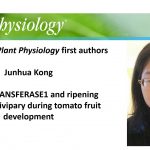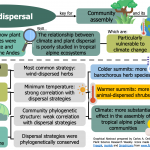Plant Science Research Weekly: June 12th
Review: Guard cell metabolism and stomatal function
 Stomatal conductance, gs, is one of the most important and highly regulated plant processes. Lawson and Matthews review how guard cell metabolism, stomatal anatomy and patterning, and signals from the mesophyll affect gs which in turn affects plant productivity and water use efficiency. This is an excellent review in its breadth; it covers all processes that control stomatal conductance, from hydraulic capacity and supply, the contribution of subsidiary cells in monocot stomata, starch and sucrose metabolism, ion transport, and coordination between mesophyll and guard cells. One to put on your teaching list! (Summary by Mary Williams @PlantTeaching) Annu. Rev. Plant Biol. 10.1146/annurev-arplant-050718-100251
Stomatal conductance, gs, is one of the most important and highly regulated plant processes. Lawson and Matthews review how guard cell metabolism, stomatal anatomy and patterning, and signals from the mesophyll affect gs which in turn affects plant productivity and water use efficiency. This is an excellent review in its breadth; it covers all processes that control stomatal conductance, from hydraulic capacity and supply, the contribution of subsidiary cells in monocot stomata, starch and sucrose metabolism, ion transport, and coordination between mesophyll and guard cells. One to put on your teaching list! (Summary by Mary Williams @PlantTeaching) Annu. Rev. Plant Biol. 10.1146/annurev-arplant-050718-100251
Review: Targeting root ion uptake kinetics to increase plant productivity and nutrient use efficiency
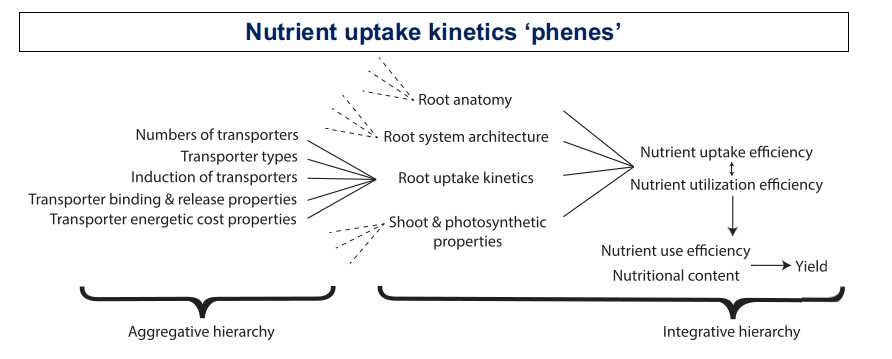 Continuous agricultural production is required to feed the growing population, and fertilizers are important factors determining the productivity of today’s high-input agriculture. Fertilizers increase the cost of production, some are produced from finite sources, and some create environmental concern, moreover a great proportion of the nutrient(s) applied through fertilizer(s) never meet the crop. To cope with this situation, improving crop varieties with better nutrient use efficiency is important, which requires an understanding of nutrient uptake, transport and root system architecture. Understudied in this regard are the effects of number of transporters, types of transporters, induction of transporters, transporter binding and release properties, and transporter energetic costs. Griffiths and York discuss and review the theory of ion movement and uptake, and the advantages and disadvantages of various practical approaches for such studies. Variation in phenotypes related to nutrient uptake kinetics and in the associated genes/alleles are also presented indicating scope for pre-breeding and further crop improvement for nutrient use efficiency and thus sustainable agriculture. (Summary by Hari Gowthem G @HariGowthemG) Plant Physiol. 10.1104/pp.19.01496
Continuous agricultural production is required to feed the growing population, and fertilizers are important factors determining the productivity of today’s high-input agriculture. Fertilizers increase the cost of production, some are produced from finite sources, and some create environmental concern, moreover a great proportion of the nutrient(s) applied through fertilizer(s) never meet the crop. To cope with this situation, improving crop varieties with better nutrient use efficiency is important, which requires an understanding of nutrient uptake, transport and root system architecture. Understudied in this regard are the effects of number of transporters, types of transporters, induction of transporters, transporter binding and release properties, and transporter energetic costs. Griffiths and York discuss and review the theory of ion movement and uptake, and the advantages and disadvantages of various practical approaches for such studies. Variation in phenotypes related to nutrient uptake kinetics and in the associated genes/alleles are also presented indicating scope for pre-breeding and further crop improvement for nutrient use efficiency and thus sustainable agriculture. (Summary by Hari Gowthem G @HariGowthemG) Plant Physiol. 10.1104/pp.19.01496
Review: An extended root phenotype: the rhizosphere, its formation and impacts on plant fitness
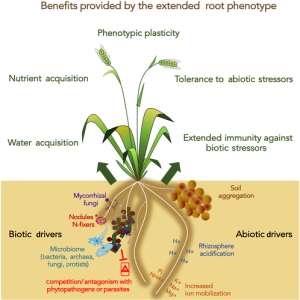 The rhizosphere is a continuous space for microbial colonization that comprises the rhizospheric soil, the rhizoplane (root surface), and the root endosphere, which is the apoplastic space in the root cortex. It is inhabited by unique populations of microorganisms, influenced by plant genotype and the surrounding soil organisms, and has a great impact on plant nutrition and health, so a better understanding of its formation and its interaction with soil and microorganisms is needed. Most research has focused on the impact of the microbiome on plant growth, or the effect of soil on plant-microbe interactions, but the study of three-way interactions of soil-microbe-plants on rhizosphere traits is lacking. In this review, Canto et al. address current understanding of how plants and soil shape the rhizosphere. The authors discuss how plant roots impact soil structure, how plants change physicochemical properties of the rhizosphere, and how microbial communities are impacted by the roots in the rhizosphere. The authors also show how the physicochemical composition and microbial populations in the rhizosphere are beneficial for plants in obtaining nutrition from the soil and to adapt to biotic and abiotic stress conditions. (Summary by Sunita Pathak @psunita980) Plant J. 10.1111/tpj.14781
The rhizosphere is a continuous space for microbial colonization that comprises the rhizospheric soil, the rhizoplane (root surface), and the root endosphere, which is the apoplastic space in the root cortex. It is inhabited by unique populations of microorganisms, influenced by plant genotype and the surrounding soil organisms, and has a great impact on plant nutrition and health, so a better understanding of its formation and its interaction with soil and microorganisms is needed. Most research has focused on the impact of the microbiome on plant growth, or the effect of soil on plant-microbe interactions, but the study of three-way interactions of soil-microbe-plants on rhizosphere traits is lacking. In this review, Canto et al. address current understanding of how plants and soil shape the rhizosphere. The authors discuss how plant roots impact soil structure, how plants change physicochemical properties of the rhizosphere, and how microbial communities are impacted by the roots in the rhizosphere. The authors also show how the physicochemical composition and microbial populations in the rhizosphere are beneficial for plants in obtaining nutrition from the soil and to adapt to biotic and abiotic stress conditions. (Summary by Sunita Pathak @psunita980) Plant J. 10.1111/tpj.14781
Modulation of gene expression in plants with orthogonal regulatory systems
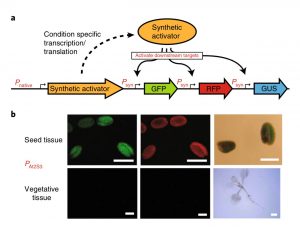 Some of the most promising applications in synthetic biology need precise control of gene expression. For instance, metabolic engineering in plants requires the expression of enzyme-coding genes at a precise time, space, and quantity to ensure correct output. Recently, Belcher, Vuu, and colleagues engineered an orthogonal system (that does not interfere with other cellular processes) to modulate gene expression in plants. They exploited the well-characterized yeast GAL4 transcriptional module and adapted it for use in plants. They characterized the system at two primary levels: cis-elements, sequences in the promoters; and trans-elements, modifications in activations/repression domains in the transcription factors (TF). The authors tested promoter strength using combinations of different cis-elements from yeast and minimal promoters from plants. To develop systems where gene expression can be induced in specific tissues or in response to specific stimuli and with controlled levels of activity, the authors used the tissue-specific activators (At2S3, endosperm-specific), or environmental response activators (AtPht1.1, low phosphate-induced), and explored other transcription factors such as MADS, HOMEOBOX, GATA, and bZIP as additional trans-elements, which allowed them to develop hybrid promoters designed to bind multiple TFs to have more precise control of the transcriptional output. This work opens the door to introducing more complex genetic circuits to plants, and will allow the generation of new tools to modulate gene expression in plants for synthetic biology applications. (Summary by Humberto Herrera Ubaldo @herrera_h) Nature Chem. Biol. 10.1038/s41589-020-0547-4
Some of the most promising applications in synthetic biology need precise control of gene expression. For instance, metabolic engineering in plants requires the expression of enzyme-coding genes at a precise time, space, and quantity to ensure correct output. Recently, Belcher, Vuu, and colleagues engineered an orthogonal system (that does not interfere with other cellular processes) to modulate gene expression in plants. They exploited the well-characterized yeast GAL4 transcriptional module and adapted it for use in plants. They characterized the system at two primary levels: cis-elements, sequences in the promoters; and trans-elements, modifications in activations/repression domains in the transcription factors (TF). The authors tested promoter strength using combinations of different cis-elements from yeast and minimal promoters from plants. To develop systems where gene expression can be induced in specific tissues or in response to specific stimuli and with controlled levels of activity, the authors used the tissue-specific activators (At2S3, endosperm-specific), or environmental response activators (AtPht1.1, low phosphate-induced), and explored other transcription factors such as MADS, HOMEOBOX, GATA, and bZIP as additional trans-elements, which allowed them to develop hybrid promoters designed to bind multiple TFs to have more precise control of the transcriptional output. This work opens the door to introducing more complex genetic circuits to plants, and will allow the generation of new tools to modulate gene expression in plants for synthetic biology applications. (Summary by Humberto Herrera Ubaldo @herrera_h) Nature Chem. Biol. 10.1038/s41589-020-0547-4
Role of two phosphatases in state transition of Chlamydomonas
 Plants and green algae can rapidly adapt to changing light conditions. Depending on light availability or other metabolic needs, Light Harvesting Complexes (LHC) II can be reallocated to photosystem I (PSI) from photosystem II (PSII) and vice versa. This is known as state transition and is mediated by kinases and antagonistic phosphatases via LHCII trimer phosphorylation. Cariti et al. characterized the homologs of two thylakoid phosphatases from Arabidopsis, PPH1 and PBCP, in Chlamydomonas to better understand the dynamics of state transition in green algae. The single mutants for each phosphatase had a slower pace of state transition and the double mutant remained locked in, thereby suggesting a role of PPH1 and PBCP in state transition. Under conditions favoring state transition, the LHCII trimers had high levels of phosphorylation in either pph1 or pbcp single mutant and pph1:pbcp double mutant. It was thus inferred that both PPH1 and PBCP had different but overlapping target proteins, thus playing a partially redundant role in state transition of Chlamydomonas. (Summary by Ananya Mukherjee @ana_m1490) Plant Physiol. 10.1104/pp.20.00384
Plants and green algae can rapidly adapt to changing light conditions. Depending on light availability or other metabolic needs, Light Harvesting Complexes (LHC) II can be reallocated to photosystem I (PSI) from photosystem II (PSII) and vice versa. This is known as state transition and is mediated by kinases and antagonistic phosphatases via LHCII trimer phosphorylation. Cariti et al. characterized the homologs of two thylakoid phosphatases from Arabidopsis, PPH1 and PBCP, in Chlamydomonas to better understand the dynamics of state transition in green algae. The single mutants for each phosphatase had a slower pace of state transition and the double mutant remained locked in, thereby suggesting a role of PPH1 and PBCP in state transition. Under conditions favoring state transition, the LHCII trimers had high levels of phosphorylation in either pph1 or pbcp single mutant and pph1:pbcp double mutant. It was thus inferred that both PPH1 and PBCP had different but overlapping target proteins, thus playing a partially redundant role in state transition of Chlamydomonas. (Summary by Ananya Mukherjee @ana_m1490) Plant Physiol. 10.1104/pp.20.00384
The biogenesis of CLEL peptides involves several processing events in consecutive compartments of the secretory pathway
 Small signaling peptides are cleaved from precursor proteins by the action of proteases and are also subject to other post-translational modifications. Subtilases (SBT) are mostly extracellular proteases, but SBT6.1 is membrane-localized at the Golgi and plasma membranes. Furthermore, it has been shown to cleave precursors of the CLE-Like (CLEL) peptides, specifically CLEL6 and 9, which are involved in root gravitropism in an SBT6.1-dependent manner. Where and when these proteolytic activities happen in the cell is not known. In this paper, Stührwohldt et al. used cell biology and genetic experiments to show that CLEL6 and 9 are proteolytically processed after exit from endoplasmic reticulum by SBT6.1 and SBT3.8 as they travel through the Golgi, post-Golgi compartment and apoplast. SBT6.1 acts mainly in the Golgi, and cleavage of the pro-CLEL6 to immature CLEL6 is necessary for it to move onwards through the secretory pathway. Post-translational modification is also required for subsequent activity by SBT3.8 mostly in post-Golgi compartment or apoplast resulting in mature peptide. This study demonstrates “the complexity of post-translational precursor maturation allowing for stringent control of peptide biogenesis.” (Summary by Vijaya Batthula @Vijaya_Batthula) eLIFE 10.7554/eLife.55580
Small signaling peptides are cleaved from precursor proteins by the action of proteases and are also subject to other post-translational modifications. Subtilases (SBT) are mostly extracellular proteases, but SBT6.1 is membrane-localized at the Golgi and plasma membranes. Furthermore, it has been shown to cleave precursors of the CLE-Like (CLEL) peptides, specifically CLEL6 and 9, which are involved in root gravitropism in an SBT6.1-dependent manner. Where and when these proteolytic activities happen in the cell is not known. In this paper, Stührwohldt et al. used cell biology and genetic experiments to show that CLEL6 and 9 are proteolytically processed after exit from endoplasmic reticulum by SBT6.1 and SBT3.8 as they travel through the Golgi, post-Golgi compartment and apoplast. SBT6.1 acts mainly in the Golgi, and cleavage of the pro-CLEL6 to immature CLEL6 is necessary for it to move onwards through the secretory pathway. Post-translational modification is also required for subsequent activity by SBT3.8 mostly in post-Golgi compartment or apoplast resulting in mature peptide. This study demonstrates “the complexity of post-translational precursor maturation allowing for stringent control of peptide biogenesis.” (Summary by Vijaya Batthula @Vijaya_Batthula) eLIFE 10.7554/eLife.55580
Systemic signaling during abiotic stress combination in plants
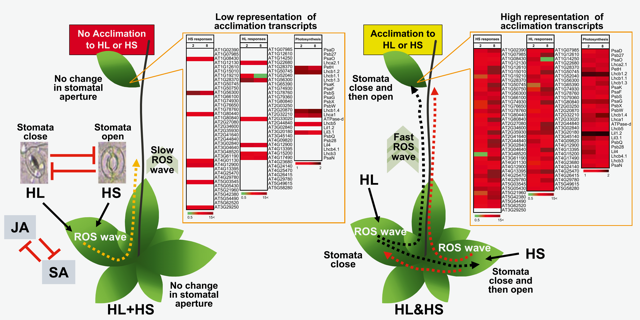 In nature, plants face multiple environmental stresses simultaneously. Plant responses to combined stresses are often not merely the sum of responses to individual stresses; in the tissue that initially perceive stresses (local tissue), plants can integrate different stress signals to elicit unique responses. Plants can also respond to stresses systemically by sending signals from the local tissue to the distal part of the plant, triggering stress-specific systemic responses important for stress acclimation. To date, however, it is unknown whether plants can integrate systemic signals simultaneously provoked by different stresses. Zandalinas et al. addressed this problem by applying high light and heat stress to the same or different leaves and analyzing transcriptome responses of systemic leaves. The authors found that plants can integrate different systemic signals, i.e., systemic responses to the combined stresses were distinct from those to the single stresses. Such responses were more pronounced when the two stresses were applied to different leaves than the same leaves; only the former condition led to acclimation to light or heat stress. By comparing these conditions, the authors showed that the local accumulation of the plant hormones SA and JA is associated with the systemic ROS signal, which may mediate transcriptional reprogramming in the systemic leaves during the combined stress. This study sheds light on the mechanisms by which plants coordinate responses to complex and heterogeneous environmental stresses at the whole-body level. (Summary by Tatsuya Nobori @nobolly) PNAS 10.1073/pnas.2005077117
In nature, plants face multiple environmental stresses simultaneously. Plant responses to combined stresses are often not merely the sum of responses to individual stresses; in the tissue that initially perceive stresses (local tissue), plants can integrate different stress signals to elicit unique responses. Plants can also respond to stresses systemically by sending signals from the local tissue to the distal part of the plant, triggering stress-specific systemic responses important for stress acclimation. To date, however, it is unknown whether plants can integrate systemic signals simultaneously provoked by different stresses. Zandalinas et al. addressed this problem by applying high light and heat stress to the same or different leaves and analyzing transcriptome responses of systemic leaves. The authors found that plants can integrate different systemic signals, i.e., systemic responses to the combined stresses were distinct from those to the single stresses. Such responses were more pronounced when the two stresses were applied to different leaves than the same leaves; only the former condition led to acclimation to light or heat stress. By comparing these conditions, the authors showed that the local accumulation of the plant hormones SA and JA is associated with the systemic ROS signal, which may mediate transcriptional reprogramming in the systemic leaves during the combined stress. This study sheds light on the mechanisms by which plants coordinate responses to complex and heterogeneous environmental stresses at the whole-body level. (Summary by Tatsuya Nobori @nobolly) PNAS 10.1073/pnas.2005077117
UDP-glucosyltransferase regulates grain size and abiotic stress tolerance associated with metabolic flux redirection in rice
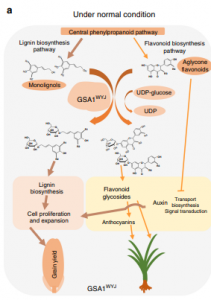 Climate change severely affects plant growth and jeopardizes yields of essential seed crops such as rice. Still, the mechanisms underlying the synergistic regulation of abiotic stress response and important agronomic traits remain poorly understood. Dong et al. cloned and characterized a major QTL in rice, named Grain Size and Abiotic stress tolerance 1 (GSA1) after its function. They obtained a set of Chromosome Segment Substitution Lines (CSSLs) by crossing an African variety (CG14, O. glaberrima) with an Asian variety (WYJ, O. sativa japonica), and identified GSA1 as novel genetic determinant of seed size. High resolution mapping revealed that the causal gene encodes a UDP-glucosyltransferase, which catalyzes glucosylation of flavonoids and monolignols. Strikingly, a single amino acid substitution in a conserved domain results in lower affinity for the substrate, and consequently decreased glucosyltransferase activity. The Nearly Isogenic Line (NIL) NIL-GSA1CG14 -carrying the weak allele of African rice- produced smaller grains compared to the NIL-GSA1WYJ control and showed higher sensitivity to abiotic stresses. By contrast, plants overexpressing GSA1WYJ not only produce bigger grains but also better tolerate salinity, drought and elevated temperatures. GSA controls cell proliferation and expansion by indirectly regulating components of the auxin signaling pathway via feedback regulation of flavonoid biosynthesis. On the other hand, GSA1 plays crucial roles in redirecting the metabolic flux between branches of the phenylpropanoid pathway, resulting in the accumulation of antioxidants which protect plants against oxidative damage. GSA1 will be a valuable gene for rice breeding programs aimed at improving crop productivity as well as tolerance to environmental limitations. (Summary by Michela Osnato @michela_osnato) Nature Comms. 10.1038/s41467-020-16403-5
Climate change severely affects plant growth and jeopardizes yields of essential seed crops such as rice. Still, the mechanisms underlying the synergistic regulation of abiotic stress response and important agronomic traits remain poorly understood. Dong et al. cloned and characterized a major QTL in rice, named Grain Size and Abiotic stress tolerance 1 (GSA1) after its function. They obtained a set of Chromosome Segment Substitution Lines (CSSLs) by crossing an African variety (CG14, O. glaberrima) with an Asian variety (WYJ, O. sativa japonica), and identified GSA1 as novel genetic determinant of seed size. High resolution mapping revealed that the causal gene encodes a UDP-glucosyltransferase, which catalyzes glucosylation of flavonoids and monolignols. Strikingly, a single amino acid substitution in a conserved domain results in lower affinity for the substrate, and consequently decreased glucosyltransferase activity. The Nearly Isogenic Line (NIL) NIL-GSA1CG14 -carrying the weak allele of African rice- produced smaller grains compared to the NIL-GSA1WYJ control and showed higher sensitivity to abiotic stresses. By contrast, plants overexpressing GSA1WYJ not only produce bigger grains but also better tolerate salinity, drought and elevated temperatures. GSA controls cell proliferation and expansion by indirectly regulating components of the auxin signaling pathway via feedback regulation of flavonoid biosynthesis. On the other hand, GSA1 plays crucial roles in redirecting the metabolic flux between branches of the phenylpropanoid pathway, resulting in the accumulation of antioxidants which protect plants against oxidative damage. GSA1 will be a valuable gene for rice breeding programs aimed at improving crop productivity as well as tolerance to environmental limitations. (Summary by Michela Osnato @michela_osnato) Nature Comms. 10.1038/s41467-020-16403-5
SMAX1-dependent seed germination bypasses GA signalling in Arabidopsis and Striga
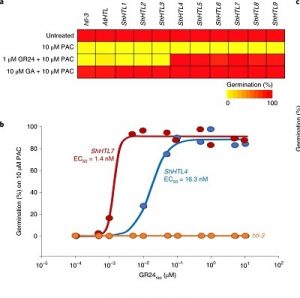 Strigolactones (SL) are germination cues for parasitic plants, as their seeds will not germinate until they perceive SL exuded from the host plant. In contrast, gibberellins (GA) are the dominant germination hormone in non-parasitic plants; GA-mediated degradation of DELLA repressors permits germination. Similarities between SL and GA signaling logic have been observed, suggesting a probable crosstalk between both pathways but this understanding remain elusive. Bunsick et al. demonstrated that Arabidopsis thaliana was able to evade GA requirement for germination in the presence of a synthetic SL, through the ectopic expression of ShHTL4 & 7, SL receptors from Striga hermonthica. Arabidopsis has an HTL receptor also, which can promote germination in response to smoke-derived karrikins, but usually plays a minor role in germination. HTL acts through the F-box protein MAX2, which inactivates SMAX1 repressor proteins to promote germination. Interestingly, SL-activated germination in GA-depleted arabidopsis seeds was lost in a loss-of-function mutation of MAX2 in ShHTL4 & 7 lines, suggesting that ShHTL receptors require MAX2 for signaling in Arabidopsis. Furthermore, loss of SMAX1 function allows germination in the presence of DELLA repressors. As the authors conclude, “Our data suggest that ligand-dependent inactivation of SMAX1 in Striga and Arabidopsis can bypass GA-dependent germination in these species.” (Summary by Toluwase Olukayode @toluxylic) Nature Plants 10.1038/s41477-020-0653-z
Strigolactones (SL) are germination cues for parasitic plants, as their seeds will not germinate until they perceive SL exuded from the host plant. In contrast, gibberellins (GA) are the dominant germination hormone in non-parasitic plants; GA-mediated degradation of DELLA repressors permits germination. Similarities between SL and GA signaling logic have been observed, suggesting a probable crosstalk between both pathways but this understanding remain elusive. Bunsick et al. demonstrated that Arabidopsis thaliana was able to evade GA requirement for germination in the presence of a synthetic SL, through the ectopic expression of ShHTL4 & 7, SL receptors from Striga hermonthica. Arabidopsis has an HTL receptor also, which can promote germination in response to smoke-derived karrikins, but usually plays a minor role in germination. HTL acts through the F-box protein MAX2, which inactivates SMAX1 repressor proteins to promote germination. Interestingly, SL-activated germination in GA-depleted arabidopsis seeds was lost in a loss-of-function mutation of MAX2 in ShHTL4 & 7 lines, suggesting that ShHTL receptors require MAX2 for signaling in Arabidopsis. Furthermore, loss of SMAX1 function allows germination in the presence of DELLA repressors. As the authors conclude, “Our data suggest that ligand-dependent inactivation of SMAX1 in Striga and Arabidopsis can bypass GA-dependent germination in these species.” (Summary by Toluwase Olukayode @toluxylic) Nature Plants 10.1038/s41477-020-0653-z
A single gene underlies the dynamic evolution of poplar sex determination
 Dioecy (male and female flowers residing on distinct individuals) has independently arisen several times in angiosperms, yet the genetic basis of dioecy remains obscure. Here, Müller et al. reveal a single gene that acts as a sex-determination switch throughout the Populus genus. A negative regulator of cytokinin, the Populus ortholog of ARABIDOPSIS RESPONSE REGULATOR 17 (ARR17) initiates female development when switched ‘on’, and male development when ‘off’. In the Y chromosome, partial ARR17 duplicates lie adjacent to known sex-linked genes. The duplicates are inversely repeated, suggesting that upon transcription double-stranded RNA may form and be processed into small RNAs that can trigger RNA-directed DNA methylation, resulting in male-specific silencing of ARR17. CRISPR– Cas9 mutants confirmed the feminizing role of ARR17, with female arr17 plants lacking carpels but producing functional stamens, while male arr17 lines were phenotypically unchanged. To investigate whether the ARR17 system is conserved, white poplar, which is an unusual Populus in that it possesses ZW sex chromosomes instead of XY, was sequenced. Remarkably, a natural arr17 knockout was discovered on the Z chromosome, meaning males lack ARR17 (ZZ-male, ZW-female), which likely facilitated the evolution of white poplar’s ZW-system. Examining the evolution of Populus sex-determining regions revealed two independent origins of ARR17 repeats, with one seemingly predating Populus speciation. Future discoveries in other lineages will enable exciting comparisons with this elegant single-gene switch, unveiling connections between sex determination and species evolution. (Summary by Caroline Dowling @CarolineD0wling) Nature Plants 10.1038/s41477-020-0672-9
Dioecy (male and female flowers residing on distinct individuals) has independently arisen several times in angiosperms, yet the genetic basis of dioecy remains obscure. Here, Müller et al. reveal a single gene that acts as a sex-determination switch throughout the Populus genus. A negative regulator of cytokinin, the Populus ortholog of ARABIDOPSIS RESPONSE REGULATOR 17 (ARR17) initiates female development when switched ‘on’, and male development when ‘off’. In the Y chromosome, partial ARR17 duplicates lie adjacent to known sex-linked genes. The duplicates are inversely repeated, suggesting that upon transcription double-stranded RNA may form and be processed into small RNAs that can trigger RNA-directed DNA methylation, resulting in male-specific silencing of ARR17. CRISPR– Cas9 mutants confirmed the feminizing role of ARR17, with female arr17 plants lacking carpels but producing functional stamens, while male arr17 lines were phenotypically unchanged. To investigate whether the ARR17 system is conserved, white poplar, which is an unusual Populus in that it possesses ZW sex chromosomes instead of XY, was sequenced. Remarkably, a natural arr17 knockout was discovered on the Z chromosome, meaning males lack ARR17 (ZZ-male, ZW-female), which likely facilitated the evolution of white poplar’s ZW-system. Examining the evolution of Populus sex-determining regions revealed two independent origins of ARR17 repeats, with one seemingly predating Populus speciation. Future discoveries in other lineages will enable exciting comparisons with this elegant single-gene switch, unveiling connections between sex determination and species evolution. (Summary by Caroline Dowling @CarolineD0wling) Nature Plants 10.1038/s41477-020-0672-9
Plant dispersal strategies of high tropical alpine communities across the Andes
 Since dispersal is crucial for the assembly of plant communities, a better understanding of its relation to climate is needed to predict plant communities’ responses to changes in the environment. However, this kind of association is still missing in tropical alpine ecosystems –one of the most vulnerable to climate change. In this paper, Tovar et al. evaluated the correlation between the dispersal strategies (i.e., the combination of seed dispersal mode and growth form) of 49 summits across the Andes with climatic variables. Also, they assessed how the dispersal strategies were associated with species phylogeny. The authors found that the minimum air temperature had a stronger correlation with the relative abundance of dispersal strategies than phylogeny. For instance, colder summits had a higher relative abundance of autonomous-dispersed herbs, while animal-dispersed shrubs and trees were the most dominant in warmer sites. Given this, the authors suggest that a warmer climate could allow animal-dispersed and woody species to outcompete species with other dispersal strategies, highlighting a particular risk for some high-Andean species to climate change. However, the authors observe the need for including more dispersal and reproductive traits –such as seed size and plant clonality– to make more robust inferences. Summary by Carlos A. Ordóñez-Parra @caordonezparra) J. Ecol. 10.1111/1365-2745.13416
Since dispersal is crucial for the assembly of plant communities, a better understanding of its relation to climate is needed to predict plant communities’ responses to changes in the environment. However, this kind of association is still missing in tropical alpine ecosystems –one of the most vulnerable to climate change. In this paper, Tovar et al. evaluated the correlation between the dispersal strategies (i.e., the combination of seed dispersal mode and growth form) of 49 summits across the Andes with climatic variables. Also, they assessed how the dispersal strategies were associated with species phylogeny. The authors found that the minimum air temperature had a stronger correlation with the relative abundance of dispersal strategies than phylogeny. For instance, colder summits had a higher relative abundance of autonomous-dispersed herbs, while animal-dispersed shrubs and trees were the most dominant in warmer sites. Given this, the authors suggest that a warmer climate could allow animal-dispersed and woody species to outcompete species with other dispersal strategies, highlighting a particular risk for some high-Andean species to climate change. However, the authors observe the need for including more dispersal and reproductive traits –such as seed size and plant clonality– to make more robust inferences. Summary by Carlos A. Ordóñez-Parra @caordonezparra) J. Ecol. 10.1111/1365-2745.13416


